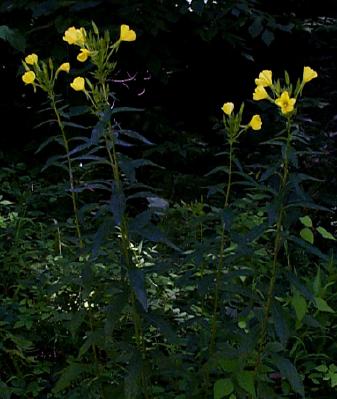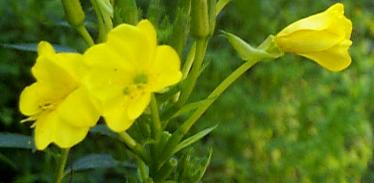|

|
HOME
Botanical
Terms
 Lists:
Master Plant
List
Flowering Times
List
Flowers by
Color/Type
Endangered
Species List
Habitat
List
Lists:
Master Plant
List
Flowering Times
List
Flowers by
Color/Type
Endangered
Species List
Habitat
List
Use the 'back' button on your browser to return, if
necessary.
|
|
 In dark woods,
this plant stands out well.
In dark woods,
this plant stands out well.
|
FAMILY:
Evening Primrose Family (Onagraceae)
DESCRIPTION:
A variable plant with a leafy stalk
bloom and lemon-scented large (1 - 2") yellow
flowers. Flowers have 4 petals and 4 sepals and
stem from a long floral tube. Also has a pronounced
cross-shaped stigma. Grows 2 - 5' tall. The leaves
are slightly toothed lanceolate 4 - 8" long.
FLOWERS:
June to October
HABITAT:
Fairly common along roadsides, waste
places, and in unfurrowed fields with generally dry
soils.
|
|
OTHER INFORMATION:
This is a night-flowering biennial which
opens in the evening (hence the name), but in
deeper, darker woods may stay open all the time.
There are many different species of this genus.
|
I
didn't quite capture the characteristic
'cross-shaped' stigma in this picture, but
at least it's a close-up of the
flower.
|

|
Medical research on the oils of this plant
have revealed some interesting characteristics. The
plant may have an anti-clotting factor useful to
heart attacks caused by blood clots. Also, it may
provide some relief for people suffereing from
eczema due to allergy, a skin irritant. There may
also be some interest in this plant for people
suffering from atopic diseases such as migraine and
asthma. The U.S. FDA of course has declared that no
drugs containing Primrose oil may be sold in the
U.S.
|
OTHER OBSERVATIONS:
My observations about this plant can be found at:
OFFSITE INFORMATION:
Another picture and a bit more information is available
at the
aaa
A picture of the flower plus seeds and other pictures are
available at
Rutgers
|
|
![]()
![]()
![]()
![]()
![]()